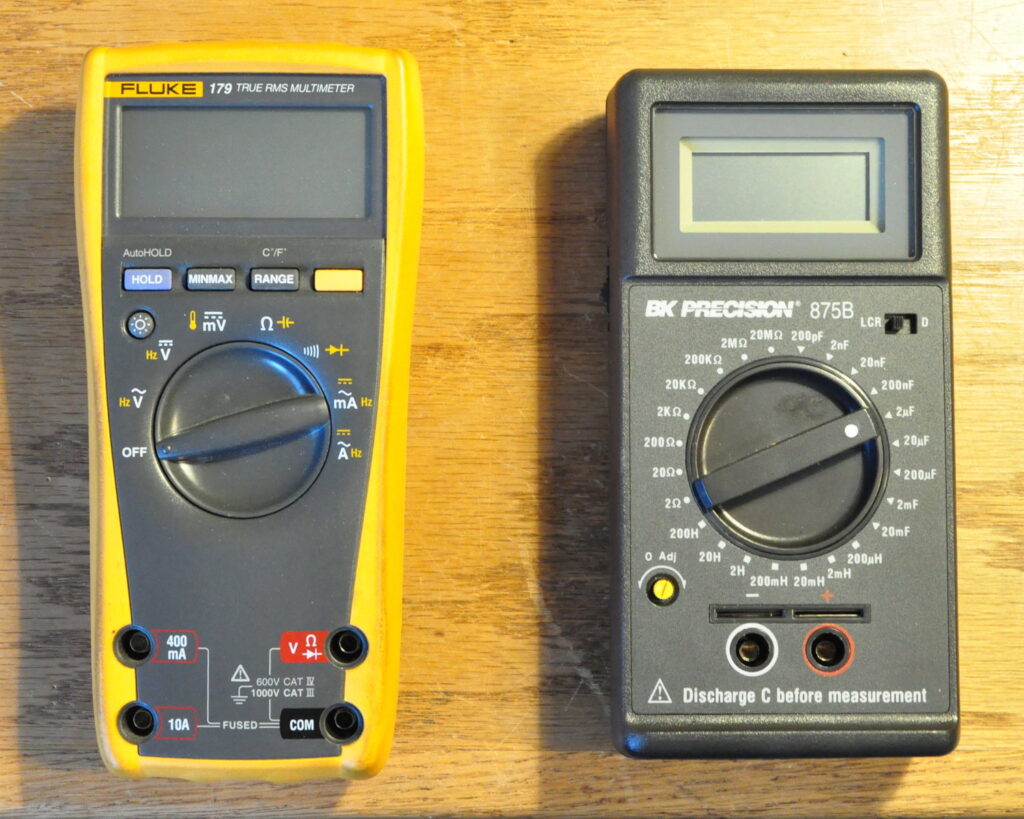A couple of quick topics today. The first is about meters and the features we (well “I”) seem to over look. The second is a quick bit of news about transformers.
It been a lazy and snowy day here at Cascade Tubes, so decided to just make a quick post about a couple of topics as I sit looking out the window of my office.
Meters and Functions
The first of those topics is about hand held meters and taking things for granted. I have two small hand held meters that see the majority of the test equipment usage at my desk. The first is my tried and true Fluke 179 True RMS Multimeter. The second is my BK Precision 875B dedicated LCR meter. Virtually all the point measurements taken at my desk involve one or both of these meters.
The 875B LCR meter was purchased many years ago when my primary meter was truly a VOM (Volt/Ohm Meter) with none of the added functionality of the Fluke 179. The 179 was an upgrade to replace some of my older meters.
My BK sees most of its use when I’m sorting components. This happens when I am getting parts set aside for projects and when I order bulk parts. When working on stereo (or multichannel) amplifiers I want the channels to match as closely as possible. The BK 875B helps me match bypass and coupling capacitors between channels, filter inductors in split power supplies, as well as critical resistances. I also often order components (especially capacitors and inductors) in bulk, buying between 10 and 20 at a time. Then I can measure all the components and either mark them with true values, or bin them for added precision. I rely on this meter so much that any time I need to measure inductor or capacitor values I instinctively reach for it.
The 179 is my voltage and resistance measurement workhorse. So much so that I rarely measure resistances on the BK except for series resistances of large inductors. However, the other day when doing some final checks on the 6L6 Spalted Alder, I wanted to measure the coupling capacitors. I started to reach for the 875B then remembered I could do this with the 179 (which was already in my hands) as well. I was already on the Ohms scale so I simply touched the yellow function button and took the capacitance measurements. One more touch of a button and I was back to measuring resistances. It was nice to not be required to switch meters.
The 179 has a few other functions which are nice to have as well. These include a simple continuity function with a beep (so you don’t have to look up at the display) and a diode check function. I have begun using the continuity function when making sure I have proper ground continuity (especially for safety grounds) in my amps. I also recently used the diode check function with a handful of surplus power diodes I purchased on-line; finding a few bad ones in the lot.
The modern meters (and not just the Fluke meters) have started to include more and more of these functions extra functions. So much so that I learned my trusty 875B was discontinued by BK precision in April of this year. There just isn’t as much of a market for the dedicated meters with the basic multimeters integrating more and more functionality every year. I’m glad I still have my 875B if for no other reason than the capacity to test a large range of inductors.
If you measure a lot of inductors, you might want to see if you can find a BK Precision 875B on closeout. Although some of it’s functions are being supplanted by basic multimeters, it’s still a nice tool to have on your workbench.
A Note on Transformers
It has been my experience that transformers are one of the most misunderstood of electronic components. The basic theory seems to get jumbled by many on various forums and in many YouTube videos.
As such I was pleasantly surprised this morning when I opened my email and discovered that Brian Weston at Edcor is doing a series of blog posts on transformers. It was described this way in the email.
This is Part 1 of a multi-part blog series [sic] will cover the basics of transformer design. Part 1 of this blog series covers the basic transformer theory, parts of a transformer, and transformer schematic.
The link to part one can be found here:
https://edcorusa.com/blogs/hi-tek-gadgeteer-notes/transformer_design-part01
I encourage everyone reading this to take a look at the first post and follow along. Edcor has been building great transformers for a long time. I look forward to learning something new from Brian.
And if you still haven’t seen Brian’s post from October “The Making of an EDCOR Transformer“, I highly recommend it as well.
As always, questions and comments are welcome.



Matt,
I had never even heard of Edcor before visiting your website, so thanks for enlightening me! I placed my first order with them three days ago (xfmrs for the 6DJ8 HPA project). Always good to have great parts sources.
Yep, between my Rigol oscilloscope and Klein Tools true RMS DMM, there is virtually nothing that I can’t measure (can’t directly measure inductance). In addition to these, I have an analog scope, several other hand held DMM’s, a bench DMM, a tube type VTVM, an FET VTVM, an analog VOM, a home brew function generator, and an ancient tube type RF and AF signal generator.
Nice snowscape BTW.
I would agree that Edcor is the hobbyist’s best option at this point for transformers. The shipping is not cheap, but if you buy more than one item then it evens out. I recently purchased some transformers for a guitar amp, and they arrived a day or two before the promised delivery date.
Interesting article Matt. Must be starting to get cold with the nice dusting of snow there. Here at the opposite end of the world just about, summer arrived and the warm doona traded for the lighter one.